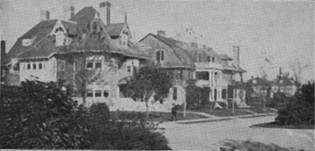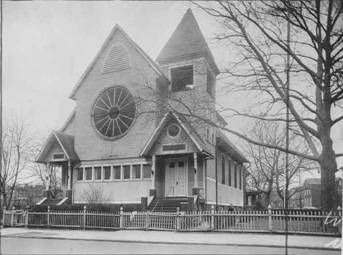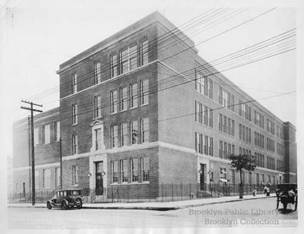|
By Patrick Fenton
One frigid March night in 1945, as a strong wind blew across the
school yard, several hundred people made their way into the auditorium of
Public School 10 on Prospect Avenue in Windsor Terrace, Brooklyn. They
were people who drove trolley cars for a living, people who worked shoveling
coal at the Con Ed plant in downtown, Brooklyn. Among them were a few
bar owners, a few candy store owners, a fruit store owner. Over in one
section of the auditorium a large group of Italians from 18th Street sat together.
Many of them didn’t speak English.
Up on a stage someone had set up an easel with a large map of Windsor Terrace
that showed the part of it that ran from 15th Street up to the gates of
Greenwood Cemetery. At the top of it were the words “Report #3334,” and then
under that in big, black letters, the words, “MODIFICATION OF THE MASTER PLAN
OF EXPRESSWAY HIGHWAYS AND MAJOR STREETS. City of New York, City Planning
Commission.”
They were meeting here tonight because a man called Robert Moses had this
plan to run a depressed highway right through their neighborhood. He wasn’t
here tonight, they were told, but a representative from his office would give
them a detailed account of his plan. It would run for more than six blocks
through Windsor Terrace, and it would take with it several factories along
with some stores. If approved, it would bulldoze down 400 houses in
their neighborhood described on the plan up on the stage as “400 frame and
brick dwellings.” The plan called for the removal of 1,252 families to make
way for a six-lane highway that would run from 4th Avenue down to Ocean
Parkway.
Hard to say what was going through their minds that night down in Public
School 10, the very school that many of them attended when they were young,
the school that many of their children now attended. The hardest hit would be
the part of 18th Street which was made up mostly of Italian Immigrants. Moses
said he had to run it right down one side of 18th Street where they lived and
also down one side of 19th Street. He needed six entire city blocks to make
his plan work. It would be called the Prospect Expressway and it would hook
up the Gowanus Parkway with Ocean Parkway. He said it would “provide much
needed traffic relief and an important link between the Gowanus Parkway and
Ocean Parkway.” And “of course,” his representative said, “the City Planning
Commission would do its best to relocate the families whose houses would be
razed.”
The records show that a lot of crying went on at that meeting that night, a
lot of anger too. Somebody screamed out, as two police officers from the 72nd
Precinct pulled him out of the auditorium, that Moses was building “a Chinese
Wall” that would “divide Windsor Terrace forever.” Originally, they were
going to run it down part of 17th Street, but after the parish Church,
Holy Name of Jesus, complained that they would lose more than 800 families
with 2,000 church members, along with more than 800 pupils, they moved it a
block over to 18th Street.
Ten years later in the fall of 1954, after the last holdout was forced
out of his house on 18th Street, an old Italian man who spent decades
delivering ice and coal in the neighborhood, after all the condemnation
proceedings were completed in court, a spokesperson for the Brooklyn Borough
President’s office said of the project, “we believe it is money well spent,
and we express thanks to the 1,252 tenants on the expressway right-of-way who
had accepted the hardship of finding new living quarters.” What was left was
row after row of empty, ghost houses that ran for miles through Windsor
Terrace.
Billy Coffey remembered how he would go over to 18th Street and wander
through the empty rooms. He remembered going down to the basements that were
flooded with water as pipes froze and burst. He remembered seeing old steamer
trunks floating by, and in them were letters and black and white pictures of
children making their first communion, children being baptized up at Holy
Name Church, the very items that once gave witness that these families
existed. And he never understood why they were left behind, as if they didn’t
mean anything anymore.
He remembered waking up one hot summer, morning and hearing this loud sound
of wood cracking, of glass breaking. Later, when he walked around the corner
to 18th Street he watched as men hosed down the streets to keep the dust down
as bulldozers started to rip down house after house. And then he watched them
tear into the entranceway to the Lucky Penny Candy Store, and after that,
Frank’s Pizza Parlor, and the American Barber shop, and soon an entire
neighborhood, an entire small town was gone, buried as if it was lost in some
sort of ancient Egyptian sand storm, never to be heard from
again.
Every few years Billy Coffey would drive back to his old neighborhood in
Windsor Terrace, and visit the part of it that existed in his mind as a ghost
town. He always went alone. Few, if any of the new people who live in Windsor
Terrace now, know that it once existed. He would always come back in the dead
of winter when 9th Avenue was empty, and all the side streets leading up to
it were quiet except for the occasional scrape of a lone, snow shovel
somewhere. And he would open up a can of beer and stare down onto the canyon
that is the Prospect Expressway as the wind whistled and snow swirled up its
sides. And all the while there was the constant noise of out of town trailers
and cars whizzing by.
And he would imagine for a moment the small town that once thrived here, a
vital part of Windsor Terrace that was bulldozed into the ground by master
builder Robert Moses in the early 50's to make way for an expressway that
would hook up with Ocean Parkway that ran all the way to Coney Island. It
would displace 1,252 families, many of them Italian. As if he was in a dream,
he would remember again walking through this part of his neighborhood so long
ago when he was a kid. It was like a small Italian village that ran for
several blocks. He remembered the Italian grocery stores with all their
crates of fresh fruit and greens outside, and stacks of Bacala, the dried
salty cod fish stacked in wooden boxes, and inside on the counter, large
stacks of Italian bread and vats of olives, and the strong, smell of fresh
blocks of cheese, and huge cans filled with anchovies.
As he stood on the corner of 18th Street and 9th Avenue, ghost like
whispers of what existed here once would drift up to him, distant voices of
young people laughing as they ran through long ago, gray winter afternoons,
ran past the old stores, ran down quiet, empty streets on the way home from
Holy Name parochial school as winter snow muffled their laughter, past the
red bricked factories with their cobbled stoned court yards and huge, black
iron shutters on their
windows that made you think that they would last forever. On long ago
Saturday afternoons he drove a huge heavy bicycle loaded down with meat that
he delivered for a store called, Joe the Butcher, and inside the homes he
brought the meat to there would be early morning sauces cooking and a
hurriedness that suggested the importance of every single day of life.
Like other small towns, this section of Windsor Terrace had a barber
shop, a candy store, a florist, a local diner, a pizza parlor, an Italian
grocery store, a factory, a saloon, and a rooming house which was two blocks
away on 20th Street. Up the block from the rooming house were the gates to
Greenwood Cemetery, and across the street on 9th Avenue was a huge trolley
car depot, the end of the line for a nine mile run that went all the way to
Coney Island and back every day. And right across from the trolley car barns
was McGovern’s Florist, a long row of green houses with a small store front
as you entered. All these places were part of the neighborhood until they got
separated by the highway that ran right down the middle of it. The trolley
car barns were torn down shortly after the expressway came through, and it
wasn’t much longer before the rooming house went.
He walked over to the corner of 19th Street and stood in front of the spot
where Gus’ Diner once was. He remembered in the early 50's watching this man
nicknamed “Paddy the Hawk”as he came rushing out of the doorway of the diner
to reset a trolley car line back up on
the overhead wire after it bounced loose and lost power. He would stare for
hours out the front window of the diner as the McDonald Avenue trolleys made
the sharp turn at the corner of 9th Avenue, eventually one of their lines
would bounce off of the overhead power line, particularly in the winter, and
“Paddy the Hawk” would be out there hooking it back up as sparks rained down
on him and bounced off the stubble of his beard. And all the while he would
be gritting his teeth and staring straight up at the power line until he
hooked it back up. Then with a wave to the trolley driver to drive on he
would straighten out his pea cap and head back to the diner for a cup of
black coffee. Billy Coffey used to think that he wouldn’t mind doing that for
the rest of his life.
He wouldn’t mind having everything stay just the way it was forever, and
his job would be to run out of Gus’ Diner to hook up the trolley car line
whenever it bounced off of the power line. Like scenes from an Edward
Hopper painting, this part of Windsor Terrace always seemed lonely in some
way to him, always seemed empty of crowds. Looking in the window of Frank’s
Pizza parlor you would always see only about three people at the tables. A
lone figure is getting a hair cut in the American Barber Shop, and always in
his memory as a young boy, there was this incredible sense of time standing
still.
Next to Gus’ Diner there was a three-story building with a loft where
they made ladies’ house coats. When he was 14, his friend Bobby Reese lived
above the loft with his family. An empty lot separated it from a small
factory that always had huge bails of bundled up cloth outside. His older
brother Andrew worked there for a while when he was 16.
He lived around the corner on 17th Street, and this part of Windsor
Terrace, cut off from the rest of it like a severed leg now, was once
part of his neighborhood. He ate pizza and drank bottles of Coca Cola at
Frank’s Pizza parlor, and he had his hair cut in the “American Barber
Shop.” He bought bags of candy at the Lucky Penny. On cold wintry Saturday
afternoons when the streets outside were lined with thick ribbed ice, the
windows all steamed up from the rows of coffee urns, he sat inside Gus’ Diner
eating french fries which Gus served up in brown paper bags.
This he remembered about Gus’ Diner: it was a long narrow, shadowy place, old
black and white tile floors, thick rimmed water glasses that were as heavy as
the white porcelain mugs the coffee was served in. It was always crowded with
trolley car drivers, mail men, sanitation men who would bring their brooms
and snow shovels in with them, all hunched over the long counter reading the
New York Daily News, the Daily Mirror, and eating large plates of fried eggs
and
home fries, and washing it down with mugs of steaming coffee. And now
walking around the ghost neighborhood, Billy could imagine that it still
existed.
He remembered when he was 14 watching a bulldozer drive straight into Gus’
Diner and the first thing that it lifted up and tore out was the wide front
window that Paddy the Hawk used to spend hours looking out. It made an awful
noise. And he could picture him again, this man that looked older than he
was, just staring out that window in the dead, gray of winter, waiting,
waiting as if his whole life depended on it, for one of the trolley car lines
to bounce off of the overhead power wire as they made the sharp turn onto 9th
Avenue so that he could hook it back up. He remembered watching the bulldozer
with the entire front window in the teeth of its bucket, the large black and
gold lettering of “Gus’ Diner” still visible as the bulldozer raised its
bucket high and sent the whole thing crashing into a dump truck. He
remembered standing there watching the dump truck drive off. Now on this cold
January day with no evidence that this part of Windsor Terrace ever existed,
he wondered whatever happened to Paddy the
Hawk.”
table of contents
|



